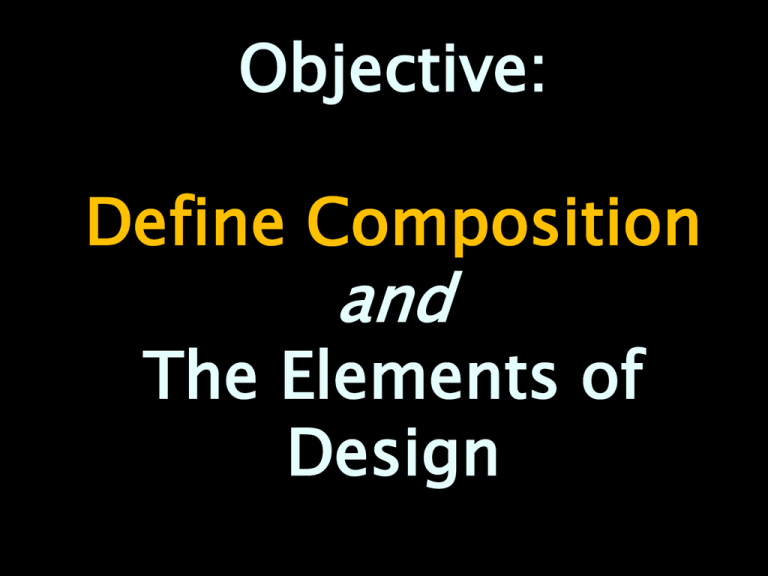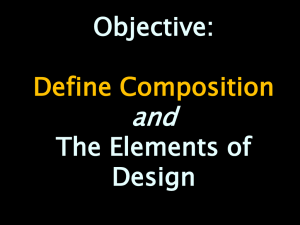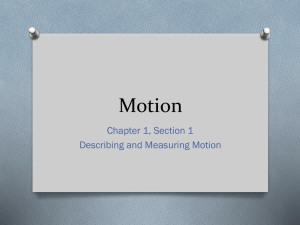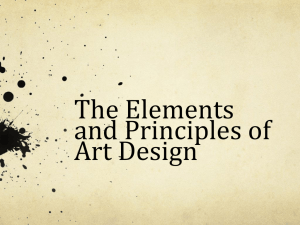The Elements of Design
advertisement

Objective: Define Composition and The Elements of Design In order to talk about an art composition, ah hem, intelligently, we need to learn a little art vocabulary. Of course, most of these words you already know…but be absolutely sure you can use them correctly when you talk about art. What is a composition? The Elements of design… The INGREDIENTS that make your art…well…art! First, let’s talk about COMPOSITION. A composition is the artwork! When we talk about the composition, we generally talk about what makes up the work of art. But how do you begin to talk about it?…Break it down into parts! In a composition is divided into three parts….the foreground, middleground, and background. foreground -appears closest to the viewer background- is perceived furthest from the viewer. middleground -located between both the foreground and background. How would you talk about composition in writing? In this sketch, the tree or bush on the right side of the composition is in the foreground. The potted plant is located in the middle ground of the composition and the house structure is in the background. The “real” definition of …. -The Elements of Design – The basic ingredients used by the artist when producing works of art. Those elements are shape, form, value, line, color, texture, and space. Ingredients? Like the things used to make your dinner? Yes, kind of!!!! Let’s say you will make a burger (or a beautiful piece of art) for dinner. I will need certain parts ingredients (or the Elements of Design) on hand to make it. What are the burger’s ingredients?…… The Ingredients (The Elements of Design) The Burger (The Composition) The Ingredients (The Elements of Design) Line The Burger (The Composition) Shape Value Form Space Color The Elements of Design You will learn the ingredients of a work of art. You will learn how to describe the Elements of Design in an artwork Line A mark made by a moving point that has length and direction. Often is defines a space, and may create an outline or contour, define a silhouette; create patterns, or movement, and the illusion of mass or volume. It may be two-dimensional (as with pencil and paper), threedimensional (as with wire) or implied (the edge of a shape or form) Words that DESCRIBE Line include; vertical, horizontal, diagonal, straight or ruled, curved, bent, points, angular, thin, thick, or wide, interrupted (dotted, dashed, broken) blurred or fuzzy, controlled, freehand, parallel, hatching, cross-hatching, meandering, and spiraling. Element of Design– white bold Principle of Design – red Describing Words – green Understanding more about Lines 3 minutes S H A P E Shape An enclosed space defined and determined by other art elements such as . line, color, value, and texture. Shapes can be categorized into two different types, Geometric, and Organic Organic An irregular shape, or one that might be found in nature, rather than a regular mechanical shape. Geometric Shapes that are created through use of mathematics. These shapes include Circle, Oval, Triangle, Square, Rectangle, Hexagon, Octagon and Pentagon. This painting by Frank Stella contains interlocking geometric shapes. Video explaining Shape This painting by James Roper shows an explosion of organic and cloudlike shapes. Element of Design– white bold Principle of Design – red Describing Words – green form Form An element of art that is three dimensional (height, width, and depth) and encloses volume. For example a triangle, which is two dimensional, is a shape, and a pyramid, which is three dimensional is a form. Examples of forms include; Cubes, Spheres, Ovoids, Pyramids, Cones, and Cylinders. Element of Design– white bold Principle of Design – red Describing Words – green Vs. Video explaining Form V A L U E Value An element of art that refers to the lightness or darkness of a color. Value is an especially important element in works of art when color is absent. This is particularly likely with drawings, lithographs, photographs, and sculpture. When you describe value in a critique, talk about the shades (darks, shades of color) and tints (lightness, highlights). Value Scale A gray scale, a series of spaces filled with the tints and shades of one color starting with white or the lightest tint on one end, and gradually changing into the darkest shade or black on the other. Element of Design– white bold Principle of Design – red Describing Words – green Color Produced by light of various wavelengths, and when light strikes an object and reflects back to the eyes. Video explaining Color Primary Colors, Secondary Colors, Complementary Colors, Warm/Cool Colors Element of Design– white bold Principle of Design – red Describing Words – green Texture An element of art, texture is the surface quality or "feel" of an object,, its smoothness, roughness, softness, etc. Textures may be Actual or Implied. Actual textures can be felt* with the fingers While simulated textures are suggested by* an artist in the painting of different areas of a picture — often in representing* drapery, metals, rocks, hair, etc. Element of Design– white bold Principle of Design – red Describing Words – green SPACE Space An element of art that refers to the distance or area between, around, above, below, or within things. It can be described as two-dimensional or three-dimensional; as flat, shallow, or deep; as positive or negative; and as actual, or illusory. Video explaining Space Element of Design– white bold Principle of Design – red Describing Words – green The artwork LETS REVIEW THE ELEMENTS! The Elements The Principles of Design These are words we use to ANALYLZE a work of art. Specifically, how the artist uses line, shape, form, color, value, space, texture (or the Elements of Design). If we use the Burger example…We have the ingredients to make our burger… how do we prepare the ingredients??? …Grill the hamburger, sauté the onions, shred the lettuce, melt the cheese…etc. Final Exam Tip: When analyzing a work you are studying how the artists used the Element of Design…so try to include that word. On each slide I included a model and additional describing words. The ELEMENT will be in black, the PRINCIPLE will be in in red and the additional describing words will be in green. Words you need to know! Symmetrical balance: where the art elements in a composition are balanced in a mirror-like fashion (it does not have to be exact but close). Asymmetrical balance: the opposite of symmetrical Element of Design– WHITE Principle of Design – red Describing Words – green Oriental Poppies, by Georgia O’Keefe Arrangement in Grey and Black: Portrait of the Painter's Mother (commonly known as Whistler’s Mother), by James Whistler Rose Window Here is how we would ANALYZE this work of art using the word, BALANCE The artist, Frangelico, balanced the small group of people in the foreground with the larger, simpler building and wall shapes in the background. Symmetrical balance is achieved because of the way the subjects are arranged on either side. Element of Design– white Principle of Design – red Describing Words – green RHYTHM and PATTERN Repeating the Elements of Design (line, color, shape, form, texture, space) to create movement or texture Here is how we would ANALYZE this work of art using the word, RHYTHM This work by Pablo Picasso uses diagonal lines, patches of colors, and varying spaces between shapes, a “dynamic” rhythm is set by the artist, creating a sense of activity. Element of Design– white Principle of Design – red Describing Words – green Here is an example of a cut paper tessellation design. What is used to create the appearance of rhythm in this work? Unity and Harmony Unity and Harmony occurs when all the elements you put in your artwork work well together and look like they belong there. All parts of the design must agree in a feeling or mood. What do you think Cezanne used to keep this painting, Mt. Victoria, unified or working together? Here is how we would ANALYZE this work of art using the word UNITY: Cézanne used blues, yellows and greens. By using related colors (remember blue and yellow make green), the piece appears to be unified. Element of Design– white Principle of Design – red Describing Words – green M O V E M E N T Movement is the art principle that uses some of the elements of art to produce the look of action or to cause the viewer’s eye to sweep over the art work in a certain manner. In Starry Night, famed artist Vincent Van Gogh creates movement in his sky. How does he show us this? Element of Design– white Principle of Design – red Describing Words – green Here is how we would ANALYZE this work of art using the word MOVEMENT: The swirling lines created by brushstrokes of colors in the sky shows the movement of wind. Look at the painting and concentrate on how your eyes bounce from one star to another. This is an example of how an artist can create movement in a work of art. Element of Design– white Principle of Design – red Describing Words – green Contrast and Variety using different types and sizes of lines, shapes, spaces, textures values and colors to bring interest to your design. Some of the most common ways of creating Contrast are by creating differences in: Sizes – large vs. small Shapes – geometric vs. organic/free Form- real vs. abstract Values – light vs. dark and Colors – warm vs. cool, complementary, intense vs. dull Textures – smooth vs. rough Line Direction – horizontal vs. vertical/diagonal/curved Element of Design– white Principle of Design – red Describing Words – green Here is how we would ANALYZE this work of art using the word VARIETY: Kandinsky used a variety of overlapping lines, shapes and colors to give this painting interest. Element of Design– white Principle of Design – red Describing Words – green The contrast in the illustration to the left is quite obvious. Notice the contrast of the light background (wall) with dark foreground (table cloth) and the contrast of the dark shadows on the tea pot and cup against the wall and with the lights of the same objects against a dark window. Element of Design– white Principle of Design – red Describing Words – green Emphasis creates a disruption to the eye’s movement in an artwork and develops a center of interest, or focal point. Where is the focal point in Wassily Kandinsky’s, Composition VII ? Element of Design– white Principle of Design – red Describing Words – green Kandinsky emphasized the large black circle (which is a shape) in the upper left corner of his work. The object is different from everything else in the painting and therefore it "stands out". Element of Design– white Principle of Design – red Describing Words – green Study Study Study good luck on your Final Exam or SLO




